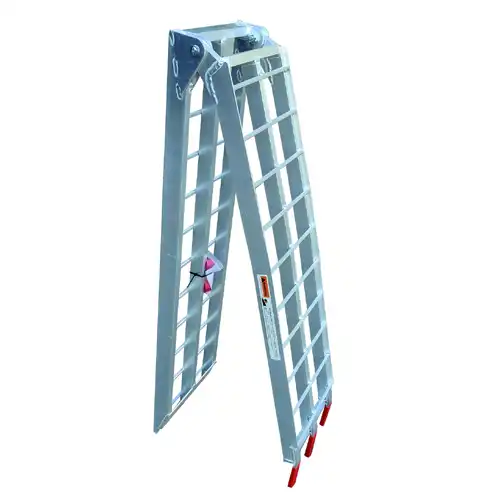How to Load a Motorcycle Using a Ramp?
Loading a motorcycle onto a truck or trailer using a ramp is a crucial skill for any rider who needs to transport their bike. The process involves selecting the right moto ramp, preparing your vehicle and bike, and executing the loading procedure safely. To successfully load your motorcycle, position the ramp securely against your truck or trailer, ensuring it's centered and at the correct angle. Start your bike, engage first gear, and slowly ride up the ramp while maintaining steady throttle control. Have a spotter guide you and be ready to assist if needed. Once on the platform, secure your motorcycle using appropriate tie-downs. With practice and proper technique, you'll master the art of using a motorcycle ramp efficiently and safely.

Choosing the Right Motorcycle Ramp
Types of Motorcycle Ramps
When it comes to selecting a motorcycle ramp, you'll encounter various options. Folding ramps are popular for their portability and storage convenience. Arched ramps provide a gentler incline, making it easier to load heavier bikes. Straight ramps are simple and versatile, while tri-fold ramps offer extra width for added stability. Each type has its advantages, so consider your specific needs and the type of motorcycle you own.
Weight Capacity and Length
Ensure the moto ramp you choose can support the weight of your bike. Most ramps have weight capacities ranging from 750 to 1500 pounds. It's crucial to select a ramp that exceeds your motorcycle's weight for added safety. The length of the ramp is equally important. Longer ramps provide a shallower angle, making it easier to ride up. A good rule of thumb is to choose a ramp that's at least 7-8 feet long for most applications.
Material and Construction
Motorcycle ramps are typically made from aluminum or steel. Aluminum ramps are lightweight and resistant to corrosion, making them ideal for frequent use and easy handling. Steel ramps are often more affordable and durable but can be heavier. Look for ramps with non-slip surfaces and safety features like side rails or straps for added security during loading.
Preparing for the Loading Process
Vehicle and Surface Preparation
Before attempting to load your motorcycle, ensure your truck or trailer is on level ground. Engage the parking brake and chock the wheels for added stability. Clean the loading area of any debris or obstacles that could interfere with the process. If loading onto a trailer, make sure it's properly hitched to your vehicle and the tongue jack is raised.
Positioning the Ramp
Place the motorcycle loading ramp securely against the edge of your truck bed or trailer. Center it to provide the straightest path for your bike. Most ramps come with safety straps or hooks - use these to attach the ramp to your vehicle, preventing it from slipping during loading. Double-check that the ramp is stable and won't shift under your motorcycle's weight.
Motorcycle Preparation
Inspect your motorcycle before loading. Check tire pressure, as properly inflated tires provide better traction on the ramp. Remove any loose items or accessories that could fall off during the loading process. If your bike has adjustable suspension, consider raising it to increase ground clearance. Familiarize yourself with your motorcycle's weight distribution to maintain balance while riding up the ramp.
Executing the Loading Procedure
Riding Technique
When you're ready to load, start your motorcycle and shift into first gear. Approach the ramp slowly and steadily, maintaining control throughout. As you ascend, gradually increase the throttle to keep smooth momentum without sudden bursts. Keep your body upright and balanced, centered over the bike's frame. Focus your eyes ahead toward the end of the ramp instead of looking down, which helps maintain stability. If the bike begins to wobble or lose balance, be ready to quickly set your feet down for support.
Using a Spotter
Having a spotter during the motorcycle loading ramp process greatly enhances safety. Your spotter should position themselves beside the ramp where they have a clear view of your progress. They can guide you in staying aligned with the ramp's center and alert you immediately if any problems arise. Before starting, agree on simple hand signals or verbal cues for smooth communication. This cooperation minimizes risks and helps ensure a successful, stress-free loading experience.
Securing the Motorcycle
After successfully loading your motorcycle onto the platform, immediately shift it into neutral and lower the kickstand for stability. Use durable, high-quality tie-down straps to firmly secure your bike. Attach the straps to strong, fixed points on the motorcycle like the frame or handlebars, then anchor them securely to your truck or trailer's tie-down locations. Slightly compress the front suspension to reduce bouncing during transport. Finally, double-check all straps and fasteners to confirm everything is tight and secure before you begin your journey.
Conclusion
Mastering the art of loading a motorcycle using a ramp is an essential skill for any rider who needs to transport their bike. By choosing the right motorcycle ramp, preparing thoroughly, and following proper loading techniques, you can ensure a safe and efficient process. Remember that practice makes perfect – the more you perform this task, the more confident and skilled you'll become. Always prioritize safety and don't hesitate to ask for assistance when needed. With these guidelines in mind, you'll be well-equipped to load your motorcycle like a pro.
Contact Us
Ready to upgrade your motorcycle loading experience? Contact RUNVA ENTERPRISES LIMITED for high-quality motorcycle ramps and accessories. Email us at info@runva.com.cn for more information on our products and how we can help make your motorcycle transportation safer and easier.
References
Johnson, M. (2022). The Complete Guide to Motorcycle Transportation. Rider's Digest Publishing.
Smith, A. (2021). Motorcycle Loading Techniques: A Comprehensive Manual. Two-Wheel Press.
Brown, R. (2023). Safety First: Proper Use of Motorcycle Ramps. Moto Safety Journal, 15(2), 45-52.
Thompson, L. (2020). Choosing the Right Motorcycle Ramp: Factors to Consider. Biker's Handbook, 8th Edition.
Garcia, E. (2022). The Physics of Motorcycle Loading: Understanding Weight Distribution. Engineering for Riders, 7(3), 112-120.
Wilson, K. (2021). DIY Motorcycle Transportation: Tips and Tricks for Safe Loading. Home Mechanic Monthly, Issue 89.

_1737625693698.webp)

